IDENTIFICATION PRIMER: THE BUTEOS
Michael Tove
For most people, the term “hawk” conjures up an image of a robust bird of prey, perched on a field-side tree limb, hunting for food, maybe including the farmer's chickens – the so-called “chicken hawk.” Within the Carolinas, this stereotypical hawk almost universally refers to the Red-tailed Hawk, a Buteo or “buzzard” hawk; the term “buzzard” referring not to vultures, but to old world hawks of the same group.
The Red-tailed Hawk or “Red-tail” as it is commonly called, represents the most common and widespread species of diurnal raptor in the Carolinas. In fact, it is the only common, permanent resident hawk species from every county of both states. However, more Buteo species occur in our region than any other group of diurnal raptor. And its members exhibit some of the most diverse plumage variation of any group of birds in North America.
The “good news” is that in the Carolinas, only two species, the Red-tailed Hawk and Red-shouldered Hawk, are common, permanent residents. A third, the Broad-winged Hawk, breeds but is absent from mid-autumn through mid-spring. Two more species, Swainson's and Rough-legged Hawks are very rare but regular winter visitors. Add to that, the specter of multiple subspecies variants, a handful of mega-rarities and incredible plumage variation among most of them, and we get to the “other news.” However, becoming “functionally proficient” in Buteo identification is greatly simplified by acquiring proficiency with just three species, of which one is absent half the year. Everything else is based on comparative familiarity with those.
Eastern Red-tailed Hawk (Buteo jamaicensis borealis) – Of the three commonly-occurring species, this is the largest and the principal species against which everything else should be compared. Five variant populations of Red-tailed Hawk have been documented from the Carolinas, the taxonomy of which can be controversial. However, only one (Eastern Red-tailed Hawk) is common and the second (Northern Red-tailed Hawk) is so similar to the former that it poses little concern except for those who wish to try their hand at subspecies identification.

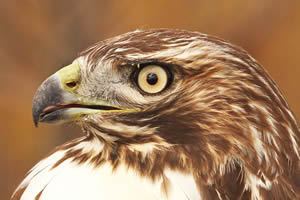
The Red-tailed Hawk is a chunky hawk with a rounded head, broad shoulders and a relatively short tail (Figure 1). The beak is significantly larger than on any other eastern North American species (Figure 2). With rare exception, the head and back are dark brown, contrasting strongly with a tan to white under-parts that are divided mid-belly by a band of dark streaks and spots; the classic “belly-band” (Figure 1). However, it is important note that the prominence and extent of this belly-band mark is extremely variable, ranging from sparsely marked light tan-brown streaks to a profusion of dark-brown streaks and spots that may, on rare occasion, extend upward onto the chest.
The back of a perched bird is nearly always accented by a patch of blotchy white along the junction of the folded wings and shoulders due to large white scapular spots (Figure 3). No other Buteo known from our region exhibits this pattern. However, highly variable, it's not always prominent in every Red-tail variant. Therefore, the presence of this feature is a strong indicator, but its absence is no guarantee of something different
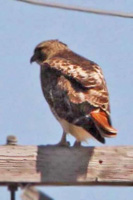
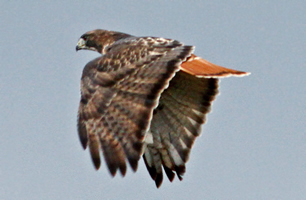
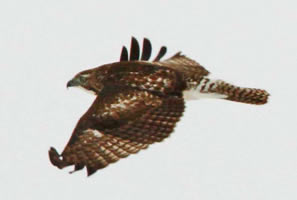
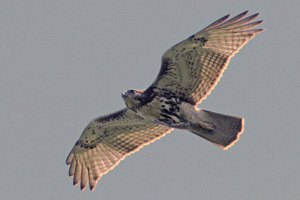
Adults have an orangey-red upper-tail from which their name is derived (Figures 3, 4). Immature birds resemble adults except they have a brown tail that is marked by multiple narrow darker wavy bars (Figure 5). In direct comparison (or by extensive experience) the tail of an immature bird is slightly longer than that of an adult.
In flight, Red-tailed Hawks show both a dark, streaked belly band and a diagnostic dark patagial bar along the leading edge of the under-wing (Figure 6). As with the rufous tail and prominent scapular spotting, this combination is diagnostic for the species
There are numerous subspecies and even recognizable populations of Red-tailed Hawk. By and large, only two forms occur in the Carolinas with any regularity. The nominate form, known as the Eastern Red-tailed Hawk (B. j. borealis) is the default morph and is the one which breeds. These birds are essentially residential and occur in all months. During winter, however, our local birds are supplemented by migrants consisting of two populations: Eastern Red-tails and Northern Red-tailed Hawks (B. j. abieticola) which breeds from northern New England and eastern Canada, west. Many authorities do not recognize the Northern Red-tailed Hawk as a legitimate subspecies separate from Eastern. However, those that do, point out that while Eastern Red-tailed Hawks have no dark morph, Northern Red-tailed Hawks do.
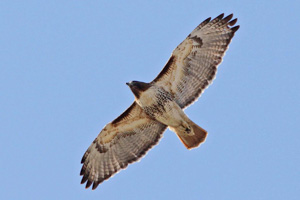
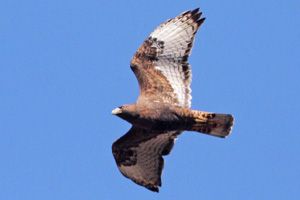
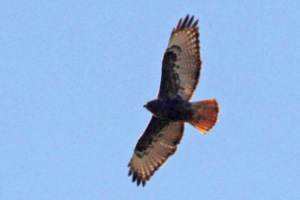




Light morph Northern Red-tails are distinguishable from Easterns by virtue of much heavier, darker markings beneath and by the presence of a dark, contrasting hood (Figure 7). Dark phase birds are extremely rare in the east but in the mid-west are not uncommon, especially during migration. In every way, they resemble traditional Red-tailed Hawks except their under-parts, including the under-wing linings are chocolate brown (Figure 8), appearing black at any distance (Figure 9). Their dorsal surfaces are also a lot darker than light morph birds but the solidly dark under-parts are all one need see to recognize a dark morph.
Within the Carolinas, three additional forms of Red-tailed Hawk are documented. Western Red-tailed Hawks (B. j. calurus) closely resemble Eastern birds except they tend to be warmer-colored underneath, (Figure 10), up to and including a cinnamon dark morph (Figure 11). Adults are distinguished by having upper tails that are marked by multiple brownish bands superimposed on the rufous base (Figure 10), visible from above and in good light, from below.
However, there is much variability in Red-tailed Hawk plumage, not only across different populations, but also within a single population, including Eastern. For example, some eastern Red-tails have minimal belly band markings (Figures 12, 13).
Except for adult Ferruginous Hawk (B. regalis) (unrecorded from the Carolinas), no other North American Buteo has an orangey-red upper tail. Thus, in the Carolinas, the presence of a bright rufous upper-tail should be regarded as definitive for Red-tailed Hawk and absent detailed subspecific identification, presumed as default, to be Eastern Red-tailed Hawk.


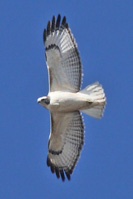


Two additional forms of Red-tailed Hawk (“Harlan's Hawk” and “Krider's Red-tailed Hawk”) that occur rarely in our region have predominately white to grayish-white tails that may or may not have some rufous coloration on their dorsal surface in adult plumage and brown banded tails in immature plumage. Harlan's Hawks range in color from coal black (Figure 14) to very white beneath. While the vast majority of Harlan's are black, the incidence of light phase birds seems to increase farther east and there is at least one record (personal observation) of a light morph Harlan's in North Carolina. Compared with Eastern Red-tails, light morph Harlan's closely resemble nominate birds except their plumage tends to be colder, gray-brown, they have predominant white markings about the face and adults (usually) have a highly variable salt-and-pepper mostly white tail that is whiter at the base. Some adult Harlan's can show a rufous washed upper tail but never the solid brick-red of typical adult eastern. To further obfuscate the matter, there are numerous intergrades of Harlan's and Northern Red-tails (Figure 15).
Another morph, the Krider's Red-tailed Hawk (Figure 16) is a very pale version of Eastern red-tailed Hawk from the northern Great Plains. Most authorities do not regard Krider's as a legitimate sub-species but it is so distinctive, it warrants discussion here. Fundamentally, Krider's is a mostly white hawk with a pale grayish-brown dorsum. As with Krider's, the upper-tail can vary from pure salt-and-pepper to washed with rufous. Krider's mostly or entirely lack a belly-band and have a minimal dark patagial under-wing bar. The head is also predominantly white.
Calling a mostly chalk-white Red-tailed Hawk type “Krider's” would be easy were it not for leucism. Within all North American raptors, Red-tailed Hawks seem to exhibit leucism and partial albinism far more than any other species. Leucistic birds may appear pale and washed out (Figure 17) or exhibit a piebald pattern of normal feathers set against pure white (albinistic) plumage (Figure 18); these so-called “partial albinos). Note that only a pure white bird, complete with pink soft-parts would qualify as a pure albino. Differentiating a leucistic bird from a Krider's rests primarily in the fact that a Krider's has distinct dark plumage on the back and does so with uniformity. Conversely, leucistic and piebald leucistic birds lack uniformly-pattered dark plumage, especially on the upper-parts.
Regardless of plumage, the one unifying character of all forms of Red-tailed Hawk in flight is the wing shape. Without exception (molt aberrancies not-withstanding) the trailing edge of the wing is broadly rounded from the body to the first of the notched primaries (“fingers”) of which there are five. In soaring flight, this combination results in a distinctive shape to the wing that can be seen at almost any distance.
The flight style of all variants of the species is predominantly soaring with minimal flapping – except when getting airborne or when the bird is in a hurry. When they do flap, it's often quicker and lighter than that of other large birds (e.g., Turkey Vulture, Osprey, Bald Eagle) but is noticeably slower and deeper than that of Red-shoulder. In addition, Red-tails often hang motionless in the air for extended periods of time as they scan the ground for a potential meal. No other regularly-occurring Buteo from our region does this.

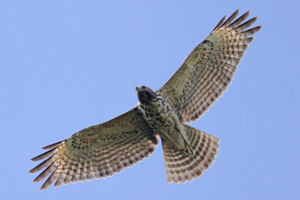

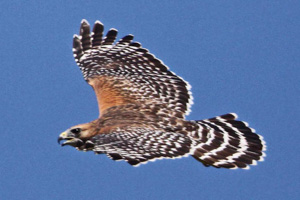
Red-shouldered Hawk (Buteo lineatus) – With rare exception, any large Buteo in the Carolinas that's not a Red-tail is a Red-shouldered Hawk. By direct comparison, Red-shouldered Hawks are smaller and slimmer but without direct comparison, be careful about relying on size alone.
Compared with Red-tail, an adult Red-shoulder is bright orangey below and lacks a belly band (Figure 19). For almost any encounter with a perched Buteo, this dichotomy is task one in the identification process and it can't be simpler: White chest with streaked brown belly band: Red-tail. Uniform orange under-parts: Red-shoulder. When perched facing away, the adult Red-shoulder's black tail with narrow white tail bands is completely different from the brick red tail of an adult Red-tailed. In addition, and Red-shouldered Hawk lacks the row of white scapula spots that is evident on Red-tailed.
Young Red-shouldered Hawks more closely resemble Red-tails than adult Red-shoulders. Like Red-tails, they have white or creamy white underparts and strong spotting but the spotting is most dense in the upper chest and becomes progressively lighter moving downward (Figure 20). The tail banding, consisting of alternating thin wavy bands of dark brown and cream, while more defined than that of a young Red-tail is not so different as to be a reliable field mark alone. Overhead, especially in strong light, young birds show a distinct pale bar-shaped region at the base of the primaries; the so-called “wing window” (Figure 20). When seen, this mark is distinctive for the species, but not seeing it does not automatically eliminate the species.
Red-shoulders have a proportionally smaller bill and longer heads and head which can be a useful distinction. Moreover, Red-shoulders are frequently “tamer” that Red-tails, allowing much closer approach. Essentially, if the bird allows you to approach it on foot, it's probably a Red-shoulder.
In flight, the combination of brick-red under-parts and bold black-and-white flight feathers and tail adult Red-shouldered Hawks is not only beautiful but also utterly distinctive (Figures 21, 22). Red-shoulders have a quicker and stiffer flap than that of a Red-tail, at times approaching that of a large Accipiter – without the classic Accipiter alternating “flap-flap-flap-glide” pattern.
Very superficially, an adult Red-shouldered Hawk can resemble either an adult Broad-winged or adult Cooper's Hawk. In the case of Broad-winged, the under-parts of Red-shouldered Hawk are orangey-red whereas Broad-winged is more rose-colored. Also, the reddish underpart coloration of Red-shoulder includes the under-wing coverts, whereas Broad-wings have essentially white under-wing linings.
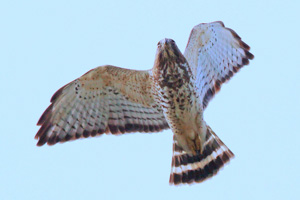
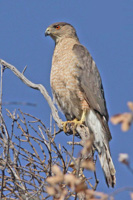
Adult Red-shouldered Hawks have a predominantly coal black tail with multiple, sharply defined narrow white tail bands (Figures 21, 22). Conversely, Broad-winged has a wide white tail-band (Figure 23), especially the trailing band, rosy rather than orange under-parts, tan to white under-wing linings and proportionally shorter wings. Finally, when seen from above, Red-shoulders have distinctive red shoulder patches (Figure 22), thereby providing the source of their name.
Confusion with adult Cooper's Hawk (Figure 24) is also possible except the under-parts of Cooper's are, like Broad-winged, rosy rather than orangey. Moreover, the shape of the two species is entirely different. Cooper's, being an Accipiter, has a very long tail that has dark bands on a white background, vs white bands on black (Red-shouldered) and Cooper's has proportionally much shorter wings with a much less pronounced “hand” and an entirely different back by color and pattern.
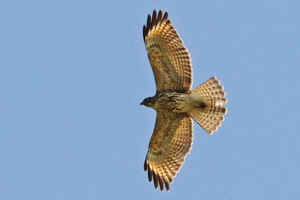
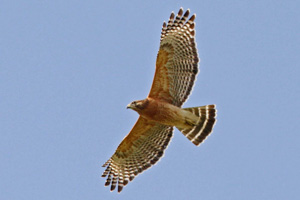
In overhead flight, Red-shouldered Hawks are often touted as showing a distinctive pale region at the base of the primaries that appears as a “wing window.” While certainly true, this characteristic is more obvious in immature birds (Figure 25), than adults (Figure 26).
As with Red-tail, the flight profile of Red-shouldered is a strong indicator of species regardless of plumage characters. The trailing edge of a Red-shouldered Hawk's wing is less convex than Red-tail and when fully extended, is raked forward such that the leading plane of the outer-wing is noticeably ahead of where the wing joins the body (Figures 25, 26).
The outer-wing of both Red-tailed and Red-shouldered Hawks possess five notched primaries, a feature that is noticeably different other species that possess only four notched primaries (e.g., Broad-winged and Swainson's Hawks)
Two subspecies of Red-shouldered hawk occur in our area. The nominate form or “northern” Red-shouldered Hawk (B. l. lineatus) (Figure 19) which breeds from northern South Carolina northward and “Southern” Red-shoulder (B. l. alleni) (Figure 26) from central florida and Texas through southern South Carolina. Differences are subtle, but adult birds are distinguishable in that northern birds have dark brown vertical streaks on the breast and southern birds do not. Differentiation of immature birds is not practical in the field and ultimately inconsequential. Note: a distinctive, pale, gray-headed form from southern Florida (B. l. extimus) does not occur in our region.
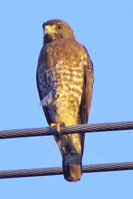
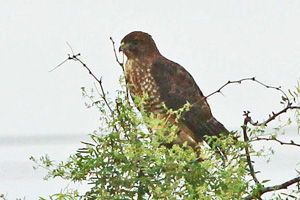
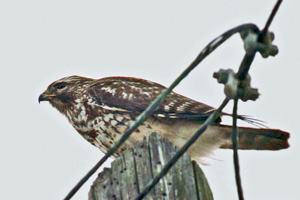
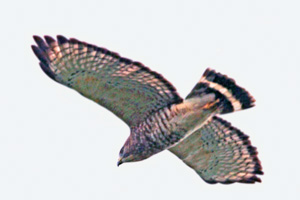
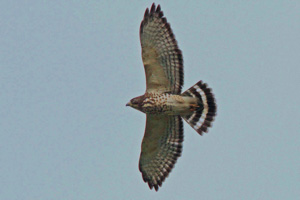
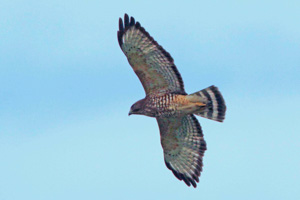
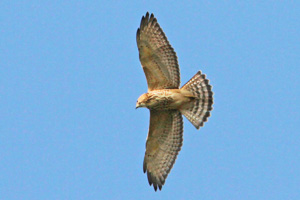
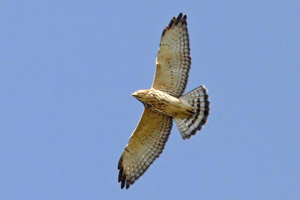
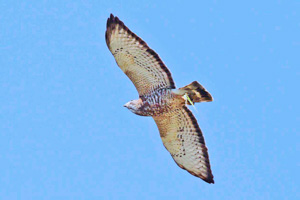
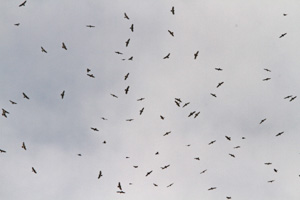
Broad-winged Hawk (Buteo platypterus) – This is our only regularly-occurring small Buteo, being half the size (by weight) of a Red-tail and more than a third smaller than Red-shouldered. Although the species breeds throughout the Carolinas, its range is predominantly montane, becoming increasingly rare toward the coastal plain. A bit secretive, Broad-wings are seldom seen perched and following a massive southbound migration in early autumn, are essentially absent until mid-spring.
An adult Broad-wing superficially resembles an adult Accipiter: barred reddish underparts with a concentration of color on the upper chest (Figures 27, 28). However, the tail of a Broad-wing is half the length of any Accipiter (Figure 24) and is much chunkier bodied. Young Broad-wings are streaked and spotted on the upper chest, becoming cleaner white below (Figure 29). As such, they resemble a young Red-shoulder but differ, plumage-wise, by being more blotchy including “cross-hatched” vertical streaks where-as the spotting of an immature Red-shouldered is separated and distinctive.
In flight, adult Broad-wings have one or more bold central white tail-bands sandwiched between black bands that border it (Figure 30). Contrary to what is often touted in field guides that emphasize, as a definitive field mark, the presence of a single white central tail band (e.g., Figure 30), adults may show two (Figure 31) or even three (Figure 32) white tail bands, both above and below. Thus while the presence of a single band is definitive for separating Broad-winged from Red-shouldered, the presence of multiple white tail bands is not.
The under-wing linings are cream-colored whereas adult Red-shoulders are brick-red. In addition, the under-flight feathers of adult Broad-wings are mostly white with thinner black bars and terminate with a wide black bar along the trailing edge of the wing.
Young Broad-wings superficially resemble young Red-shoulders except Broad-wings lack a distinctive wing window and have a very different overhead shape. The tail-banding of young birds is somewhat variable, but roughly assignable to one of two variations. 1) A series of multiple, narrow tail bands with a wider and bolder terminal band (Figure 33). 2) An adult-like pattern with wide black and white dark bands (Figure 34). However this adult-like pattern occurs only on the inner tail-feathers. The outermost two or three feathers retain the pattern of multiple narrow bands (variation 1).
Regardless of plumage, the flight profile of Broad-winged is radically different from either Red-tail or Red-shoulder. Proportionally shorter winged (Figures 30-34), Broad-winged Hawks have four notched Primaries (“fingers”) compared with five of its larger cousins. Moreover, the third outermost primary typically appears the longest, giving the species a slightly stubby, pointed-wing shape, particularly when the wing is not fully extended (Figure 35).
The flight style of Broad-winged is light and buoyant. Soaring on a slight dihedral, they have a quick, almost Accipiter-like flap and make tight turns often markedly banked turns as they thermal soar. In migration, especially fall, Broad-winged Hawks are famous for moving in large flocks called kettles (Figure 36). Most soaring hawks, kettle but Broad-wings are famous for it, sometimes moving in massive flocks that number in the thousands or even tens of thousands.
NOTE:The following species are rare to extremely rare in the Carolinas and great caution should be exercised in their identification. In all cases, identification necessarily must seek to eliminate all of the above-described three.
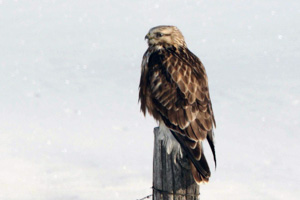
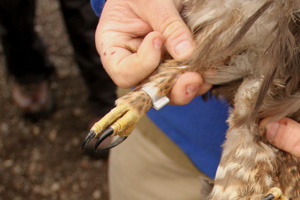
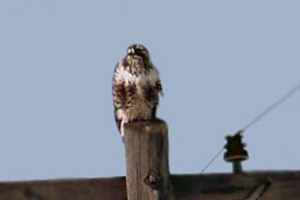
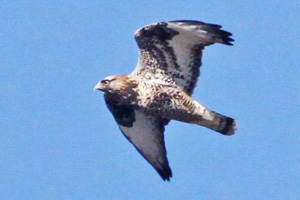
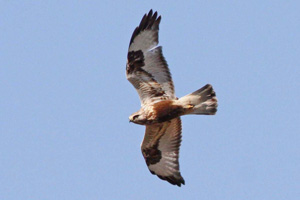
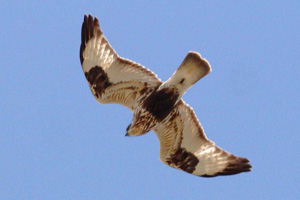
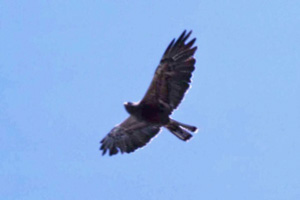
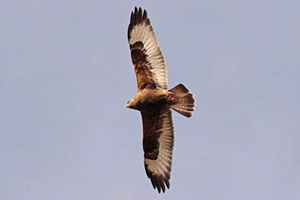
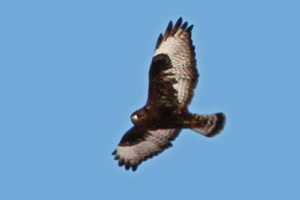
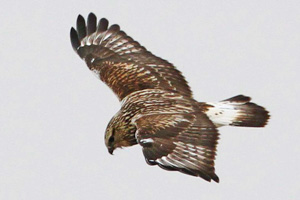
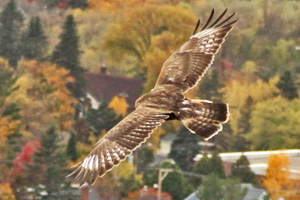
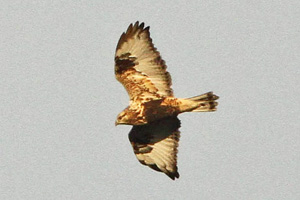
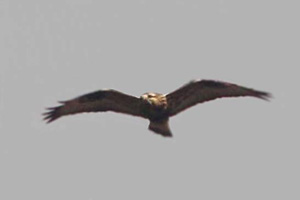
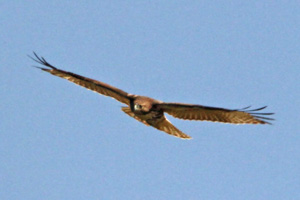
Rough-legged Hawk (Buteo lagopus) – This winter visitor from the far north probably occurs in our region every year, but is far more likely in North than South Carolina. Beyond that, there is no strong pattern of occurrence with multiple sightings in some years to no sightings in others. A bird of the open country Rough-legs typically are not seen in areas in areas dominated by dense woods.
Rough-legs are similar in size to Red-tails but with longer wings and are lighter weight. However, their bills are proportionally much smaller which, in combination with a large head presents a very different head profile. In addition, in perched birds the folded primaries are nearly as long as the tail and there is no white spotting on the scapulars (Figure 37). This combination of attributes offers a relatively reliable way to identify this species when perched without having to rely on body plumage. Anyone fortunate enough to get very close can also look for the Rough-leg's feathered tarsi (Figure 38) as opposed to the unfeathered of every other Buteo species presently recorded from the Carolinas. Relatively tame, perched Rough-legs are often approachable. However, anyone fortunate enough to get that close to a Rough-leg in the Carolinas will not likely need to see the feathered tarsi to make a definitive identification.
Rough-leg plumages are incredibly complex, ranging from birds that are nearly pure white underneath to birds that are coal black, and varies by both age and sex as well as individually. The typical field guides do a great disservice to their variability by suggesting they come in just two color phases: “light” and “dark.”
From an identification perspective, there is value in thinking about them, not as light vs. dark, but as light, intermediate and dark although doing so might seem foreign to most observers familiar with traditional field guides. However, there is more to this trichotomy than mere heuristics. Unlike any other Buteo, Rough-legged hawks can be aged AND sexed by plumage characters although this is where a more refined understanding comes into play. On the one hand, in the Carolinas, the species is sufficiently rare that a full treatise on this is excessive. However, from the perspective of identification (which is the purpose of this tutorial), being aware of the basic differences may be the difference between a correct and an incorrect identification.
For simplicity purposes, the under-body plumage of a Rough-leg can be thought of as involving markings on the chest and belly that are either streaked or solidly colored. Birds that combine lightly (Figure 39) or heavily streaked chest (Figure 40) with streaked belly regions streaked would be more properly referred to as “Light Phase.” Birds with streaked chests and solid bellies (Figures 41, 42) are “Intermediate” or “Classic” and birds with solid chests and bellies (Figures 43, 44, 45), “Dark.”
In flight, light and intermediate as well as some darker birds (Figures 40-43) have white or cream-colored under-wing linings with streaks that may be sparse to heavy. However, they invariably show a broad oval blackish wrist patch that contrasts against white primaries with black tips. In all plumages, the undersides of the flight feathers are bright white often contrasting to a dark trailing edge. In dark phase birds the strongly pigmented underwing linings may obscure or completely mask the diagnostic black wrist patches but when visible, the bold black wrist patch is a reliable mark for Rough-legged Hawk.
From above, most Rough-legs show a bold white basal tail (Figure 46) but dark birds may lack this feature (Figure 47). Young birds have a broad, uniformly dark tail band that occupies the distal half of the tail (Figure 46) that has a diffuse margin with the basal white. Adult females have a more sharply-defined single tail band that may include a narrow terminal white band (Figure 48). Adult males have multiple dark tail bands, the outermost being wider than the remainder (Figures 40, 45). Interestingly, the lightest and blackest birds are usually adult males while intermediate birds are generally young and females.
Young birds also tend to have prominent white upper-wing patches at the base of the primaries (Figure 46).
With such extreme variation in Rough-legged plumage, gaining an understanding of the shape and flight style of the species is important to accurate identification. Fortunately, the species presents a very different flight profile from other Buteos common to our region. Compared with a Red-tailed Hawk (especially), Rough-leg has longer and narrower wings. The leading and trailing edges are relatively straight and roughly parallel and terminate with five notched primaries (“fingers” wherein the middle two are longer than those beside them, resulting in a narrow, even pointed-wing profile, especially when the wings are flexed. In addition, Rough-legs commonly glide with their wings in a “W” positioned profile (Figure 49), not unlike that of an Osprey, whereas Red-tailed commonly flies with a slight dihedral (Figure 50). Finally Rough-legs commonly hunt by hovering on flapping wings whereas Red-tails will hang motionlessly.
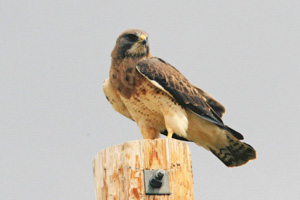
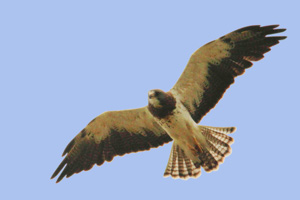
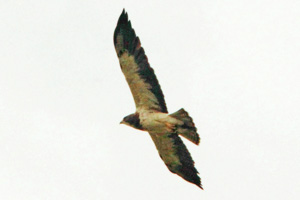
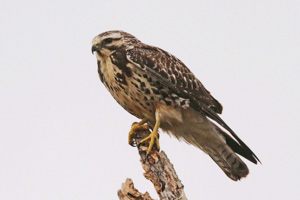
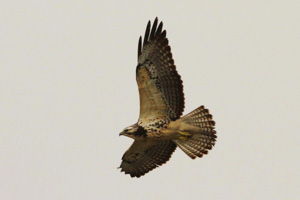
Swainson's Hawk (Buteo swainsoni) – This predominantly western species occurs as a rare, yet somewhat predictable winter visitor. Swainson's also come in multiple plumage variations, commonly referred to as “light” or “dark” although in this case, this dichotomy is a bit closer to the truth. Thus far, all birds reported from the Carolinas have been lighter morphs.
Light phase or “typical” adult birds are characterized by a grayish head, white throat, broad brown chest and white belly. In particular, the dark chest and light belly separation are sharply defined (Figure 51). Moreover, Swainson's has dark flight feathers that contrast against paler underwing coverts (Figure 52). Both Red-tailed and Rough-legged Hawks (with which Swainson's might reasonably be confused) have under-wing linings that are darker than the flight feathers,
In all cases, compared with Red-tailed Hawk, Swainson's are slimmer, have longer wings whose folded wingtips cross near the end of the tail and they have uniformly gray-brown backs that lack scapular spotting. In addition, Swainson's have four notched primaries which compared with Red-tail's five, gives Swainson's a distinctly narrow, pointed-wing shape (Figure 53).
Young Swainson's Hawks show a variable combination of dark spots and streaks concentrated around the chest which may or may not enclose a pale throat and upper chest (Figure 54) and under-wing linings paler than flight feathers (Figure 55). Regardless of the degree of coverage, these patterns are completely foreign to anyone familiar with immature plumages in Red-tailed or Red-shouldered Hawks.
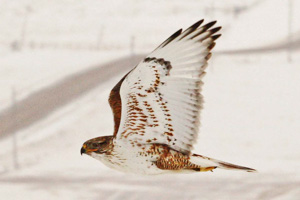
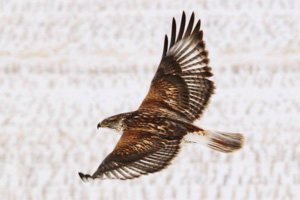
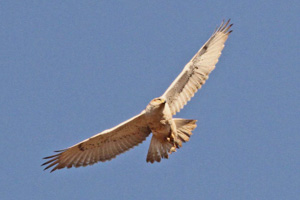
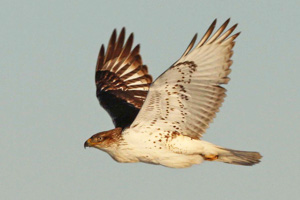
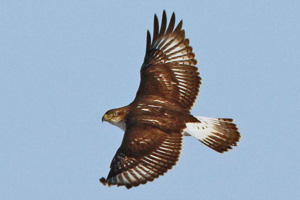
Ferruginous Hawk (Buteo regalis) – Unrecorded in the Carolinas, there are records from both southern Virginia and Florida meaning this is a species which could occur. The world's largest Buteo, Ferruginous Hawks resemble small eagles as much as they do a typical Buteo. In all plumages, they have a big flat head, noticeably wide beak (mouth gape) and at close range, feathered tarsi. Considering that seeing one in the Carolinas would (at the time of writing) constitute a first state record, clearly seeing features like this would be important proper documentation. Ferruginous Hawks also come in light and dark phases, but the latter is rare even in the center of its range and won't be covered here.
Adult plumage is distinctive, combining stark white underparts with rufous thighs – so called “leggings,” a predominantly rufous back and grayish head lighter than the back (Figure 56). From above they have a rufous back and upper-wings with bold white wing patches that stretch from the outer primaries to the body. The tail is variably gray and white with some rufous mixed in (Figure 57).
Young birds are extremely white below, with variable spotting in the belly band region but usually far less than any Red-tail (Figure 58, 59). From above they are warm brown with bold white upper wing patches and a Rough-leg-like brown tail with bold white basal band (Figure 60).
The flight profile of a Ferruginous is distinct. Their wings are long and slender but proportionally wider than that of a Rough-leg and have a distinctive white patch (visible from above) in the outer-wing. Except for some Rough-legs and Crested Caracara (no chance of confusing Ferruginous with that), no other Buteo has bold white upper-wing patches. Ferruginous Hawks soar on a slight dihedral that is more reminiscent of Golden Eagle than anything else. When in power flight, they have a slow, powerful flap.
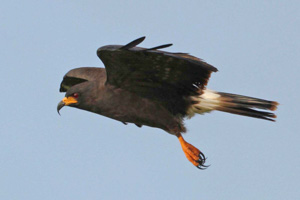
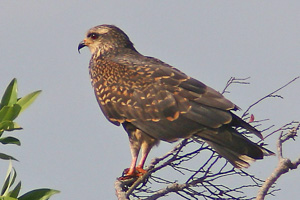
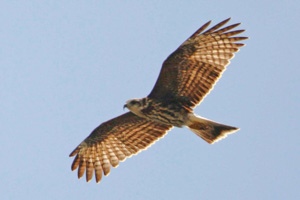
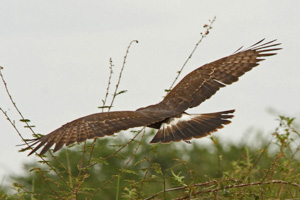
Snail Kite (Rastrhamus sociobilis) – Though not a Buteo, this Florida Everglades species superficially resembles one and has occurred in both North and South Carolina. In all plumages, the very long, slender hooked beak (for a raptor) is unique (Figure 61).
Adult males are uniform charcoal grayish black. Seeing that and the bill requires no more for identification (Figure 61).
Immatures and females are brown with heavily streaked and spotted underparts (Figure 62), a slightly notched brown tail (Figure 63) with a narrow white rump (Figure 64). The plumage is sufficiently unique for identification by itself, but that unique bill is – or should be – the key to identification.
In all plumages, the tail of a Snail Kite is white based with a dark (black = male or brown = female/immature) terminal half.
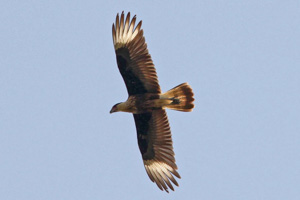
Crested Caracara (Caracara cheriway) – This bizarre relative of the falcons, within the United States, is a non-migratory resident of central Florida, Texas and along the US-Mexican border west through Arizona. It uniquely has a heavy bi-colored bill, red at the base and grayish-blue at the tip. The head and chest are white with a sharply demarked black crown and dark horizontal spotting on the chest. The mid-body area is solidly blackish-brown and the vent is white. There are large white patches in the outer-wing that are visible from both above and below (Figure 65). Open country birds, Caracaras would not be expected in wooded areas and are as likely to be seen on the ground as perched on top of a pole or other elevated structure.
Predominently Black Buteos
With very limited exception, other than vultures and eagles, no hawk in the Carolinas has a solid black body and under-wings. However, that is not to say the possibility is nil and in the event someone does see a hawk with solid black underparts, it's important to take note and pay close attention for two reasons: 1) it's rare and significant, and 2) identification is not going to be easy.
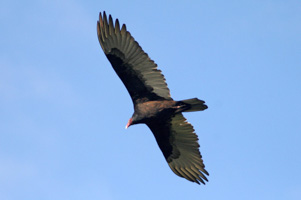
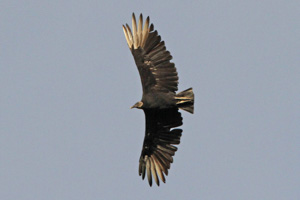
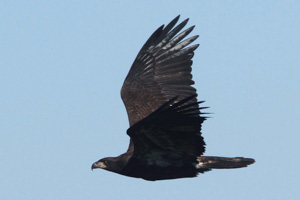
Before getting into the dark-phase hawks, it's instructive to review the three common all-dark raptors that occur in the Carolinas: Turkey Vulture (Cathartes aura) (Figure 66), Black Vulture (Corogyps atratus) (Figure 67) and immature Bald Eagle (Haliaeetus leucocephalus) (Figure 68). In all cases, these species are as large or larger than Red-tailed Hawk and should be familiar to anyone who regularly birds in the Carolinas. Except for dark Red-tailed and Rough-legged Hawks, all dark phase raptors that might occur are smaller.
Red-tailed Hawk – Essentially any black-bodied Red-tail (Figures 8, 9) is likely to be a dark phase Northern Red-tail (B. j. abieticola). Members of this subspecies are regular wintering birds in the Carolinas and dark phase birds are seen with considerable regularity in the Mid-west. Solidly dark brown to black bodies and underwings mask the traditional dark belly band and patagial bars. Adults, with brick-red tails are easy but young birds can present identification challenges. Focus on the bird's shape, especially the wing because no other dark phase Buteo will have the broad, rounded trailing wing edge of a Red-tail.
Rough-legged Hawk – of all the candidates for a dark phase bird in the Carolinas, this is the most likely. Dark phase Rough-legs can be brown or black (Figures 43-45) but in all cases will have a contrasting pure white panel in the outer primaries between the dark underwing coverts and the dark wing tips. Do not assume the bird will exhibit classic white tail base. Dark Rough-legs commonly have all dark tails. Again, wing shape is critical in aiding the identification. Compared with Red-tails, Rough-legs have long, slender wings and both have five notched primaries whereas Swainson's – which can also be dark, have four. Swainson's also differs in having dark under flight feathers. However, to date, dark phase Swainson's Hawk is unrecorded from the Carolinas.
Snail Kite – Records of this species exist for both North and South Carolina and include adult males. These birds differ from all others in the “dark phase” group in that they're uniformly slate gray, not black including have dark gray flight feathers (Figure 61). Adult male Snail Kites are the only North American raptor that combines dark gray (not black) plumage, bold white upper-tail band with bright orange legs and beak although younger birds, even though in otherwise adult plumage have a yellow-based bill (Figure 62). None of these characters are duplicated in any of the other dark phase contenders. Immature and female Snail Kites are brown with coarse longitudinal streaks that run the length of the under-parts. The tail is brown with a white base and is squared to slightly notched. Regardless of plumage characters, the, slender, deeply hooked bill is unique among raptors that would ever (reasonably) occur in our region.
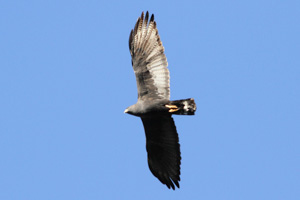
Zone-tailed Hawk (Buteo albontatus) – Shockingly, an individual of this tropical species was seen for nearly a week in September 2015 at the southernmost tip of the Delmarva Peninsula in Virginia, barely 50 miles from the North Carolina border. It had been seen up and down the east coast for at least two years and had in fact been seen migrating past Cape May Point on two consecutive years. In 2014, after being seen at Cape May, it was seen crossing the water, then coming over the hawk watch at Cape Henlopen, DE. In 2015, it was again seen at Cape May, then four hours later, over the hawk watch at Kiptopeke, VA. It was seen repeatedly over the next few days until a tropical storm swept through and was never seen again.
Zone-taileds are medium-sized, coal black hawks with a single white tail band (adult plumage) (Figure 69) or barred black and white in immature plumage. In flight, they show contrastingly paler flight feathers (underneath) and soar with their wings in a distinct dihedral. As such, they are likened to Turkey Vultures (Figure 66) than other hawks. In comparison, Zone-tails are smaller than the vultures, have proportionally larger heads that are black and feathered and they have the white and black banding on the tails. The sighting of a solidly black-colored hawk in the Carolinas is not necessarily a Zone-tailed. Red-tailed, Broad-winged, Rough-legged, Swainson's and Ferruginous Hawks all have black plumage morphs that could superficially resemble a Zone-tailed Hawk. Thus, a claim of Zone-tailed Hawk in our region necessarily must first eliminate ALL other possibilities; not just Turkey Vulture.
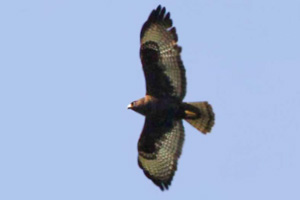
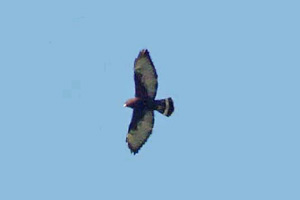
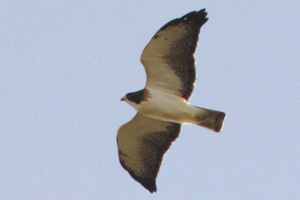
Short-tailed Hawk (Buteo brachyurus) – Unrecorded in the Carolinas, this species has occurred in Georgia less than 30 miles from the South Carolina border. Though that individual was a light-phase bird, some 80% of Short-tailed Hawks in Florida are dark and the possibility remains that “lightning could strike twice.” Compared with the other contenders mentioned, Short-tailed is small and proportionally short-winged (not actually so “short-tailed”). Dark phase birds are entirely black except for white under-flight and tail feathers, the latter being thinly banded with a wider sub-terminal band (Figure 70).
However, a small black-bodied Buteo is not automatically Short-tailed. Although exceedingly rare especially in the east, there is an east coast record of dark phase Broad-winged Hawk (Figure 71) which would be very difficult to eliminate by plumage alone. However, the one reliable difference is in counting the number of notched primaries (“fingers”); Broad-winged has four, Short-tailed has five. With adult birds, at least, the tail banding is also different. Dark Short-tailed has multiple fine dark tail bands and a wide terminal band. Broad-winged has a dark tail with a broad white central band (usually one).
Light Phase Short-tailed is a much easier call. Birds have a pure white body and underwings that contrast with a dark brown hood and darker flight feathers respectively (Figure 72). The head is dark brown with a white throat and face, thus a dark “helmet.” Other than Swainson's, no other hawk that would likely occur in our area, combines darker flight feathers with white under-wing linings. By comparison, Swainson's is much larger with a vastly different wing shape and (in most cases) a solid brown chest (not a helmet).
FALCONRY
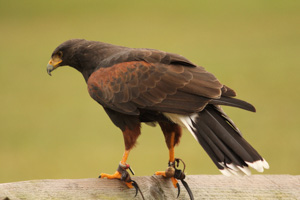
The ancient sport of falconry – the keeping and training of birds of prey for hunting – remains prevalent throughout the United States. While sentiments pro vs. con about the sport can become emotional, neither position is assumed here. Regardless, it is true that on occasion, falconer's birds escape and sometimes those birds are regionally “exotic” species. It would be impractical, if not impossible to cover the breadth of possible escapes, but one species, by virtue of its popularity, merits brief consideration: Harris's Hawk (Parabuteo unicinctus). This tropical species not only is a popular bird in falconry circles, it is a relatively common resident of southern Texas and the southwest.
Harris's Hawks are predominantly dark gray with cinnamon upper-wing coverts, under-wings and thighs. They have white under-tail coverts and a white base to an otherwise long, black tail with white tip (Figure 73). Young birds (which mature after one year so not commonly seen as falconer's birds) are streaked below but otherwise resemble adults with cinnamon upper-wings and rufous (barred) thighs.
OTHER POSSIBILITIES
If all this is not enough, a first-year Great Black Hawk (Buteogallus urubitinga) has occurred in the eastern United States. First sighted in April, 2018 at South Padre Island, Texas, it was relocated later that August in eastern Maine, continuing there through January 2019 (when it was found with frostbitten feet and had to be euthanized). This event highlights just how bizarre the possibilities may be. In addition, for many years starting in the early 1970's and possibly continuing through present, one or more Black Hawks of unsettled specific identity (Common vs. Crab, vs. Great) have occurred in and around Miami, Florida (north to Greynold's Park, North Miami Beach). The origins of these birds are unclear and so far, none has been recorded north of that narrow region of occurrence.
SUMMARY
Hawk-watching holds a special place in the world of birding and perhaps except for pelagic birding, is unparalleled as a birding specialty. The entirety of North America, including the Carolinas, is peppered with organized hawk-watching stations, mostly to record the fall migration. With few exceptions, the stars of these stations are Buteos, predominantly Broad-winged Hawks in early fall (e.g., September) and Red-tailed Hawks later (October-November). Winter in the Carolinas, presents an excellent opportunity for hawk-watching, especially along the coastal plain where large numbers of Red-tails congregate and are sometimes accompanied by rarities (usually Rough-legged and Swainson's although Harlan's and Krider's have been seen). This is what makes gaining proficiency at the identification of this group fun. Then, for those who truly like to be challenged, invest time sorting through the myriad of Red-tailed Hawks for different morphs (subspecies). They're out there for the patient student of the group. My only word in conclusion is to exercise caution when claiming anything that is uncommon or rare. This group is incredibly variable and can cause confusion at any turn. Do not be ashamed of concluding that a particular individual could not be identified. Even the most veteran hawk-watchers cannot identify every single bird they see.

